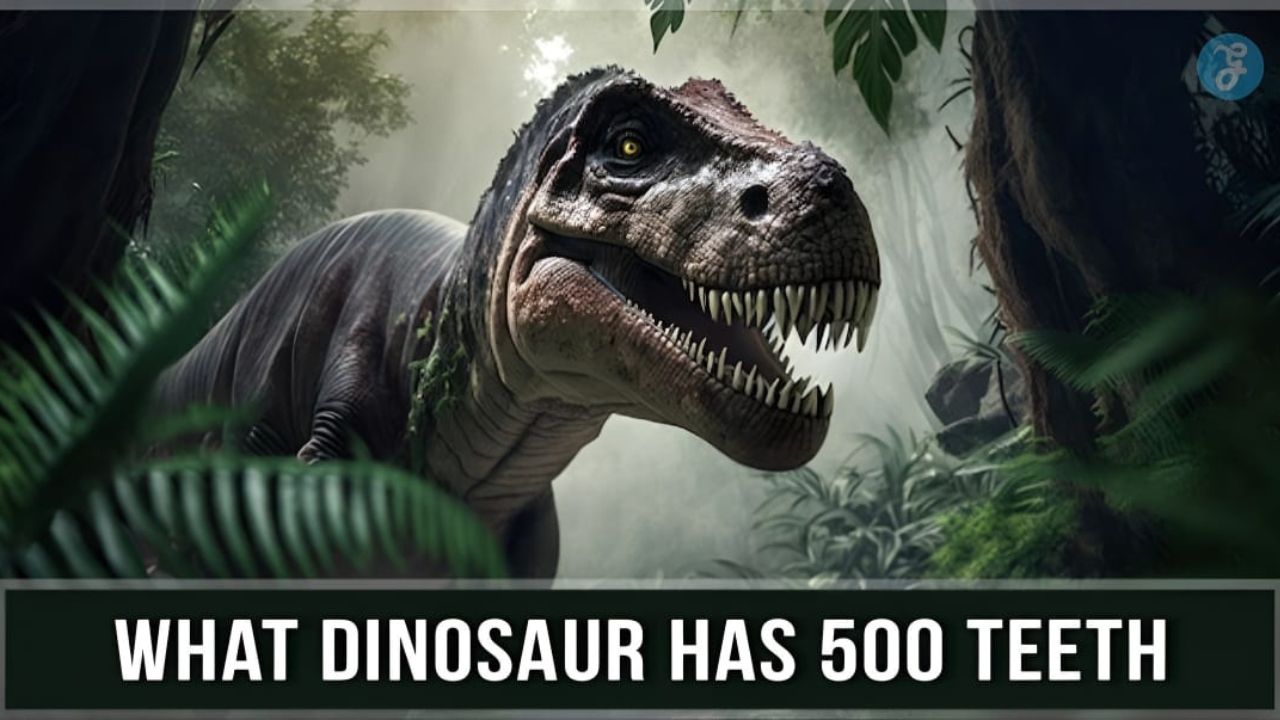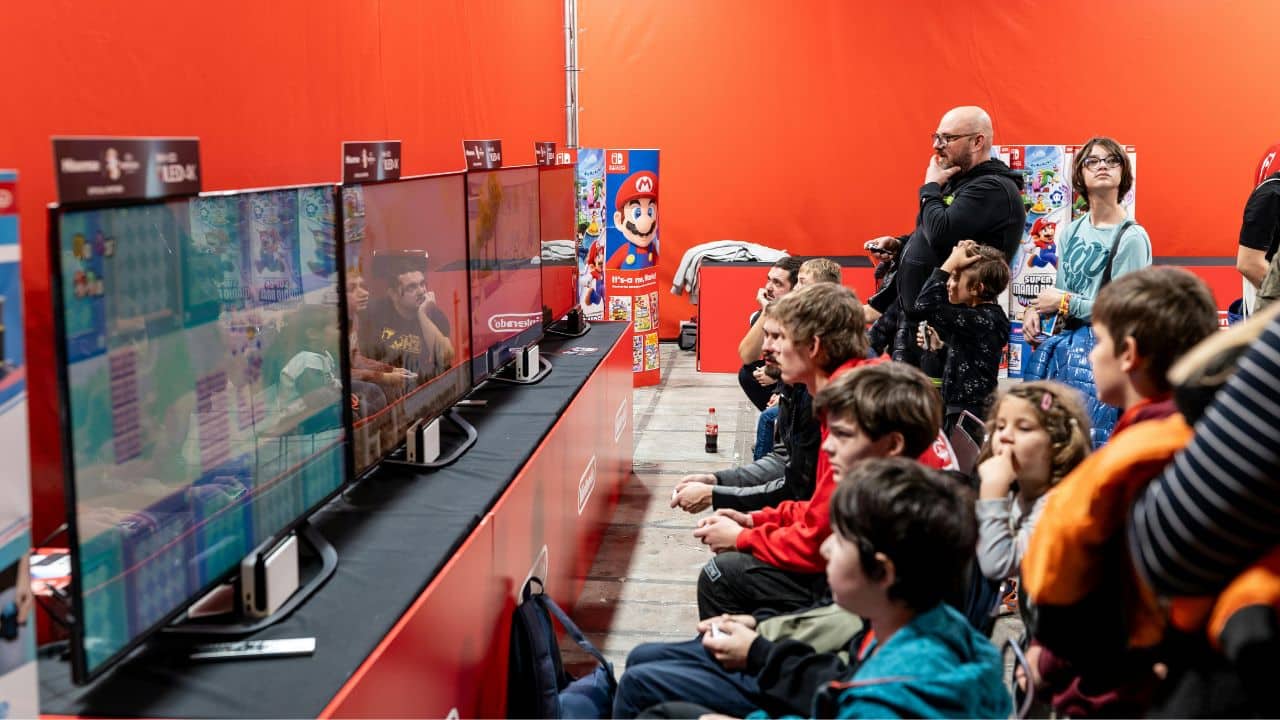Are you ready to embark on a toothy adventure into the mysterious world of dinosaurs? Imagine a creature that possessed not dozens, not hundreds, but a mind-boggling 500 teeth! Yes, you heard it right, 500 teeth! But what dinosaur has 500 teeth?
Nigersaurus, this incredible dinosaur has 500 teeth. With its unique mouth full of slender, tightly packed teeth, this sauropod roamed the ancient landscapes, utilizing its specialized dental arsenal to graze on low-lying vegetation.
So, are you willing to know more about Nigersaurus? Let’s dive deep and learn more about this topic.
What Dinosaur Has 500 Teeth?
The expedition conducted three years ago resulted in the discovery of Nigersaurus, a long-necked dinosaur. Nigersaurus gained its name from the bones found during that expedition.
One of the remarkable features of this sauropod is its unique skull, which contains an astonishing number of slender teeth, estimated to be around 500. The primary objective of the current expedition is to locate the remaining parts of this distinct dinosaur, enabling a comprehensive description and reconstruction for public display.
What Did Nigersaurus Use Those 500 Teeth for?
The purpose of Nigersaurus’ remarkable 500 teeth was closely tied to its unique feeding habits. In contrast to many other sauropods, which are commonly depicted as browsing on high-growing vegetation, Nigersaurus had evolved specialized adaptations for grazing close to the ground.
With its short legs and elongated neck, Nigersaurus possessed the ability to effortlessly access low-lying plants such as ferns and horsetails, without the need for excessive body movement. Its skull and neck were potentially lighter, enabling the dinosaur to sustain this feeding strategy over extended periods.
The grazing strategy of Nigersaurus closely resembled that of modern-day herbivores such as cows or sheep. Leveraging its specialized mouth and abundant teeth, Nigersaurus efficiently stripped leaves and stems from plants, processing substantial amounts of vegetation in a relatively short time frame.
By exploiting this feeding niche, Nigersaurus effectively carved out a distinct ecological role within its environment, one that may have been less accessible to taller sauropods. Additionally, you can also read – Dino game unblocked.
Dental Adaptations and Feeding Habits of Nigersaurus
Tooth arrangement plays a crucial role in dental function, as anyone familiar with orthodontic braces can attest.
In the dental batteries of Nigersaurus, the long-necked dinosaur, all tooth columns were precisely aligned. This distinguishing feature sets it apart from other dinosaur species, as its teeth were positioned at the front of the mouth, following the gently curved outer edge of the muzzle.
Given its unique dental structure, Nigersaurus faced different dietary challenges compared to other dinosaurs. With its relatively short neck and small body size for a sauropod, it is unlikely that Nigersaurus nibbled on treetops. Instead, evidence suggests that this dinosaur primarily fed at ground level, reminiscent of the browsing habits of modern-day cows.
Nigersaurus derives its name from the Republic of Niger, the West African country where its fossils have been discovered. During the time when Nigersaurus roamed the Earth, the landscape was characterized by forests and braided rivers, where it would have encountered the enormous crocodile relative, Sarcosuchus.
The broad muzzle of Nigersaurus, coupled with its distinctive teeth, was perfectly suited for scooping up low-lying plants such as ferns and horsetails. With its abundant teeth, the dinosaur would have effortlessly sheared through this vegetation.
However, such a feeding strategy can take a toll on dental health unless a steady supply of replacement teeth is available. Nigersaurus likely experienced rapid wear of its tooth crowns due to its feeding habits. Fortunately, it had a continuous influx of new teeth. A study published in the journal PLOS One in 2013 suggests that Nigersaurus replaced each tooth with a fresh one after just 14 days.
History And Discovery of Nigersaurus
The discovery and understanding of Nigersaurus have evolved over time. The first fossils attributed to Nigersaurus were found in Niger during a French-led expedition in the 1960s and 1970s. However, due to the fragile nature of the skull and skeleton, the fossils were poorly preserved and often disarticulated. It wasn’t until later expeditions led by American paleontologist Paul Sereno in 1997 and 2000 that more complete remains of Nigersaurus were discovered, shedding light on its anatomy.
In 1999, Sereno and colleagues officially named and described Nigersaurus based on the newly found specimens. The genus name, Nigersaurus, refers to the country of its discovery, while the specific name, taqueti, honors Philippe Taquet, who organized significant paleontological expeditions in Niger. The holotype specimen, consisting of a partial skull and neck, is housed at the National Museum of Niger.
Sereno and Jeffrey A. Wilson provided detailed descriptions of Nigersaurus’ skull and feeding adaptations in 2005. A more comprehensive examination of the skeleton, based on a specimen discovered a decade earlier, was published in 2007.
These fossils, along with a reconstructed skeleton mount and a model of the head and neck, were showcased at the National Geographic Society. The unique appearance of Nigersaurus, resembling a “Mesozoic cow,” drew attention, with comparisons made to Darth Vader, a vacuum cleaner, and other unconventional analogies. Its teeth, similar to those found in other locations like the Isle of Wight and Brazil, may or may not belong to related species or titanosaurs found in the vicinity.
The study of Nigersaurus has contributed to our understanding of sauropod dinosaurs, although the scarcity of intact skulls and articulated skeletons remains a challenge. Nonetheless, the discoveries and research surrounding Nigersaurus have provided valuable insights into its distinct anatomy and feeding adaptations.
Posture and Head Position of Nigersaurus: Insights from Inner Ear Analysis
The feeding posture of Nigersaurus, with its head directed downward, has led experts to speculate about its overall body posture. Paul Sereno and his team conducted a meticulous examination, reconstructing the internal structure of Nigersaurus’ skull. This enabled them to study the orientation of the lateral semicircular canal (LSC) within the inner ear, a crucial component responsible for maintaining balance in animals.
Based on their observations of the LSC orientation in Nigersaurus, Sereno and his colleagues proposed a hypothesis suggesting that the dinosaur likely habitually walked with its snout inclined towards the ground at an angle of approximately 67 degrees. This posture can be likened to that of a despondent teenager, with the head drooping downward.
However, other researchers have challenged this assertion. Studies conducted in 2009 and 2013 have indicated that the position of the LSC cannot reliably determine the typical head posture of any given sauropod. Consequently, further research is necessary to unravel the mysteries of Nigersaurus’ posture. If only we had a time machine at our disposal.
General Overview of Nigersaurus
|
Name |
ton |
|
Meaning |
Greek for “Niger lizard” |
|
Pronunciation |
NYE-jer-SORE-us |
|
Habitat |
Woodlands of northern Africa |
|
Historical Period |
Early Cretaceous (110 million years ago) |
|
Size and Weight |
About 30 feet long and five tons |
|
Diet |
Plants |
|
Distinguishing Characteristics |
Relatively short neck; hundreds of teeth in wide jaws |
Nigersaurus, a large sauropod dinosaur, roamed the Earth approximately 112 million years ago during the early Cretaceous period. This article explores the fascinating features and discoveries related to Nigersaurus, including its unique dental structure.
Discovery and Naming
Nigersaurus taqueti, initially discovered by French paleontologist Philippe Taquet in 1976 during his expeditions in Niger, was later more extensively excavated by American paleontologist Paul Sereno in 1999. The name “Nigersaurus” refers to its origin in Niger, while “taqueti” denotes a subspecies within this species.
Habitat and Size
Inhabiting what is now the Sahara Desert in Niger, Nigersaurus was a herbivorous dinosaur measuring approximately 30 feet in length. It coexisted with other dinosaurs like the carnivorous Suchomimus and the plant-eating Ouranosaurus.
Unique Skull Structure and Teeth
The skull of the Nigersaurus is an intriguing subject of study. Unlike most dinosaurs, it had a fragile skull with a mouth directed downward, allowing it to browse low-lying plants. The snout was wide and straight-edged, accompanied by an extraordinary feature—over 500 teeth that were continually replaced.
Morphological Quirks
Researchers have extensively examined the skull of Nigersaurus and used their findings to reconstruct the animal’s body posture accurately. The dinosaur’s vertebral column had minimal bone material, highlighting another distinct morphological characteristic.
Interest in Museums
Due to its unusual characteristics, Nigersaurus specimens are often exhibited in museums to captivate the curiosity of young visitors. The National Geographic Museum in Washington, DC, proudly showcases examples of this dinosaur species.
Nigersaurus, with its 500 teeth and distinctive skull structure, stands out among dinosaurs. Its herbivorous nature, fragile skull, and specialized dentition for browsing plants near the ground make it a fascinating subject of scientific study and public interest.
Scientific Classification: The Dinosaur with 500 Teeth
Initially, Nigersaurus was included in the genus Dicraeosaurus. However, it was subsequently reclassified by Sereno as a rebbachisaurid diplodocoid. Sereno’s reclassification was based on the observation of shorter necks in Nigersaurus, which served as an identifying characteristic of the rebbachisaurid diplodocoid group.
- Kingdom: Animalia
- Phylum: Chordata
- Genus: Nigersaurus
- Clade: Dinosauria
- Species: Nigersaurus taqueti
- Clade: Saurischia
- Clade: Sauropoda
- Clade: Sauropodomorpha
- Superfamily: Diplodocoidea
- Family: Rebbachisauridae
- Subfamily: Rebecchi Suriname
What Type of Dinosaur Nigersaurus Is?
Nigersaurus, a rebbachisaurid sauropod dinosaur, inhabited the woodlands of Niger during the middle Cretaceous period, approximately 115 to 105 million years ago. The initial discovery of Nigersaurus fossils was reported in 1976, but it wasn’t until 1999 that the dinosaur was formally named Nigersaurus taqueti, following the identification of additional and better-preserved remains.
The genus name, meaning “Niger reptile,” pays homage to its country of origin, while the specific name recognizes the contributions of paleontologist Philippe Taquet, who made the initial discoveries.
What is the Biological Family of Nigersaurus
Nigersaurus belongs to the family Rebbachisauridae. The Rebbachisauridae family is a group of long-necked, herbivorous dinosaurs that lived during the Mesozoic Era. These dinosaurs are characterized by their elongated necks, relatively short tails, and specialized teeth adapted for browsing on vegetation.
They were widespread and diverse, with fossils found in various parts of the world, including Africa, South America, and Europe. Nigersaurus is one of the well-known members of this dinosaur family.
What Does The Dinosaur With 500 Teeth Eat?
Nigersaurus was an herbivore that primarily consumed low-lying vegetation. It is compact head and elongated neck provided access to plant sources that were beyond the reach of other dinosaurs.
Initially believed to have a unique herbivorous diet, Nigersaurus is now understood to have shared dietary similarities with other sauropods. The presence of small pit-like tooth marks on its numerous parallel teeth suggests a grazing habit.
Such tooth marks are commonly found in grazing animals that feed on ground-level flora, including ferns, weeds, and other vegetation. During the time Nigersaurus inhabited the Earth, grass was not yet available as a food source. Therefore, this dinosaur with 500 teeth sustained itself by consuming horsetails, flowering plants (angiosperms), ferns, and other plants found at ground level, thanks to its rigid neck and elevated reach.
Nigersaurus exhibits similarities to modern-day flamingos. It is hypothesized that Nigersaurus may have employed a comb-like brushing motion to remove aquatic ferns and other vegetation, akin to the feeding behavior of these pink birds.
However, as suggested by Sereno, Nigersaurus may have also consumed small conifers and other plants found at ground level. Due to the lateral orientation of its teeth, Nigersaurus was unable to effectively chew plants.
This necessitated the astonishing number of 500 teeth to ensure a continuous supply of functional teeth, replacing those that became worn or decayed. The dental replacement rate of Nigersaurus far surpasses that of any other herbivorous dinosaur.
Where Did Nigersaurus Live?
Nigersaurus inhabited the Elrhaz Formation within the Tenere Group, situated in Gadoufaoua, Republic of Niger. The geological setting of this region comprised fluvial sandstones with relatively low elevations and intermittent dunes characterized by coarse to medium grain sizes.
However, during the Early Cretaceous period, the area transformed into a floodplain. The marshy environment provided an abundant supply of ground-level flora, ensuring sufficient food resources to sustain Nigersaurus.
What Predators did Nigersaurus have?
Nigersaurus, despite its unique adaptations and imposing size, faced a variety of predators in its Early Cretaceous habitat, just like other herbivorous dinosaurs.
The environment was home to formidable carnivorous dinosaurs, including Carcharodontosaurus, Suchomimus, and Spinosaurus, which posed significant threats to herbivores like Nigersaurus. Additionally, the presence of the gigantic crocodile Sarcosuchus heightened the risks even when approaching bodies of water.
To safeguard itself, Nigersaurus likely employed several defense mechanisms. Its relatively small size and lower profile compared to other sauropods may have made it less conspicuous to predators. Furthermore, the probable herding behavior of Nigersaurus, as observed in many sauropods, provided collective protection. By remaining in groups, individuals could enhance their safety by maintaining vigilance and deterring predators through sheer numbers.
This protective strategy is reminiscent of modern-day animals such as buffalo or wildebeest, which rely on the safety of their herd to survive in predator-rich environments.
In addition, Nigersaurus may have utilized its long, whip-like tail as a defensive tool. While not as robust as the tails of other sauropods like Apatosaurus or its relative Diplodocus, the tail could still have served as a deterrent against potential threats, helping to ward off predators.
Who Are the Close Relatives of Nigersaurus?
Within the Rebbachisauridae family of sauropod dinosaurs, Nigersaurus had several notable close relatives. Among them were Rebbachisaurus from Morocco, Demandasaurus from Spain, and Limaysaurus from Argentina.
These closely related dinosaurs exhibited shared skeletal characteristics with Nigersaurus, including similar vertebral structures and skull shapes. These common features provide evidence of their evolutionary connections and indicate their close relationship within the Rebbachisauridae family.
Also read: 25 animals that don’t sleep
Did Any Other Dinosaurs Have 500 Teeth?
There are no other dinosaurs with exactly 500 teeth. However, while Nigersaurus is known for its impressive count of 500 teeth, it is not the only dinosaur with such a remarkable dental arrangement. Among the dinosaur groups, the hadrosaurs were known to have even more teeth than Nigersaurus. Here are some examples:
- Edmontosaurus: This duck-billed hadrosaur boasted a dental battery containing over 1,000 teeth.
- Shantungosaurus: A close relative of Edmontosaurus, this large duck-billed dinosaur also possessed hundreds of teeth in its dental battery.
- Lambeosaurus: Another hadrosaur species, Lambeosaurus sported a hollow crest on its head and had hundreds of teeth in its dental battery.
- Corythosaurus: Similar to Lambeosaurus, Corythosaurus was a crested hadrosaur with hundreds of teeth for processing plants.
- Parasaurolophus: Known for its distinctive long, curved head crest, Parasaurolophus had hundreds of teeth in its dental battery.
- Gryposaurus: This duck-billed hadrosaur featured a prominent nasal arch and possessed over 500 teeth in its dental battery.
- Maiasaura: Dubbed the “good mother lizard” due to evidence of parental care, Maiasaura was another hadrosaur with hundreds of teeth in its dental battery.
While these hadrosaurs had dental batteries with hundreds of teeth, the next closest contender to Nigersaurus in terms of tooth count was Diplodocus, with over 100 teeth. On the other hand, ceratopsians, known for their horns, beaked mouths, and elaborate frills, generally had fewer teeth than hadrosaurs.
For instance, the well-known Triceratops had around 40-60 teeth on each side of its jaw, totaling approximately 200 teeth. Despite their impressive dental arrangements, ceratopsians typically did not possess over 500 teeth.
Frequently Asked Questions (FAQs)
Now let’s get some common FAQs on this topic.
What was the reason behind Nigersaurus having a lightweight skull?
Nigersaurus featured a lightweight skull primarily attributed to its hollow structure and the presence of numerous openings. This intriguing adaptation is thought to have served the purpose of reducing the overall weight of the skull.
What was the lifespan of Nigersaurus?
Determining the precise lifespan of the Nigersaurus is challenging due to the limited data available on dinosaur lifespans. However, based on general estimations for sauropods, it is believed that
Nigersaurus likely lived for several decades, with some individuals potentially reaching an age of up to a century.
What is Nigersaurus nickname?
Nigersaurus earned the nickname “Mesozoic Cow” due to its unique feeding behavior of browsing on low-lying vegetation. The comparison made by one of its discoverers, Paul Sereno, likened it to both Darth Vader and a vacuum cleaner, highlighting its distinctive characteristics and evoking imaginative associations.
How Big was Nigersaurus
Nigersaurus possessed unique characteristics that set it apart from other sauropods, including its size. Compared to other well-known sauropods such as Brachiosaurus or Apatosaurus, Nigersaurus was relatively small. It had a length of approximately 30 feet and weighed around 4 tons, making it significantly smaller in size.
Conclusion
I hope now you got no more confusion on the topic – what dinosaur has 500 teeth?
To recap – it’s the Nigersaurus, with its jaw-dropping 500 teeth, stands as a fascinating testament to the incredible diversity of dinosaurs.
That’s all for today, hopefully, see you again with some other interesting topics soon.








































